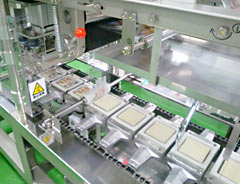280 tons of shima dofu shipped to Tokyo

Shima dofu being produced at Hokugan’s Nikko Factory in Tochigi Prefecture.
August 15, 2012 Ryukyu Shimpo
Shipments of shima dofu are on the rise. A year after it began to gradually expand the scale of its business, Hokugan Co., Ltd, which started shima dofu production at Nikko in Tochigi in 2009, increased its volume of shipment by 2.5 times, to 280 tons, and now aims to double that again. Other companies that produce shima dofu in Okinawa and ship it out of the prefecture have also lifted their profile at Okinawan product exhibitions and have increased their volume of shipment.
Starting production in Tochigi has led to a broad expansion of their business around the Tokyo metropolitan area. Hokugan has increased the volume of shipments mainly during summer by working with major companies such as Itoyokado and Ion as well as selling to small and medium-sized enterprises, Okinawan restaurants and bars. As a result, the volume of product shipped increased to a record-high of 46 tons in July in comparison to just one ton a month at the beginning of this year. Hokugan’s target is to ship more than 500 tons a year.
Michiru Miyagi a member of the company’s Planning and Development Section says, “Compared to other types of tofu, shima dofu is more elastic and flavorsome. This fact is now more well-known by customers, and as more people grow goya (bitter melon) to help counter extreme heat, the number of people who make champuru (stir-fry) with shima dofu increases as well.” Their current challenge is to come up with different ways to eat shima dofu and to get people to consume it throughout the year.
Meanwhile, Hiroshiya Shokuhin, which has been producing food in Okinawa for 38 years, has boosted its profile through Okinawan product exhibitions held across the country. Five years ago, it dispatched 30 to 40 tons from Okinawa each year, but this year shipment levels are expected to reach 200 tons, a level that would represent nearly 40% of all volume shipped.
Hachidai Itokazu, the sales manager of the company, said confidently, “We can carry out sales face to face at food exhibitions designed to showcase our products. If we sell good quality products, the customers will buy them.” Meanwhile, he is also concerned about maintaining the quality of the product, saying, “We are not sure if we will increase the volume of shipment of Okinawa because if we look to make too much, it might affect the taste.” He also referred to challenges in terms of expanding the consumption on the main islands of Japan, saying that other manufacturers may take market share from Okinawan producers if they don’t clearly define the term shima dofu.
A representative of the Sales and Distribution Division of the Okinawa Products Association, which runs Okinawa product exhibitions nationwide at least once every two months, said, “Shima dofu has a broad range of uses such as in champuru and yushi dofu, so it is easy to use in everyday meals. That is why boosting levels of consumption is relatively straightforward.”
(English translation by T&CT, Megumi Chibana and Mark Ealey)
Previous Article:Movie about Mr. and Mrs. Penguin, the couple that triggered the boom in chunky hot sesame oil condiment
Next Article:Sol-T-Shine wins at the World of Hip Hop Dance Championship
[Similar Articles]
- Ikeda Shokuhin produces smoked shima-dofu using unsold tofu
- Okinawan exports increase 43 times
- OPG’s airfreight container project for Okinawan products to five Asian cities does well
- JA Okinawa begins shipping citrus tankan Hayata to locations throughout the country
- Okinawan sea grapes become a brand product
 Webcam(Kokusai Street)
Webcam(Kokusai Street)


